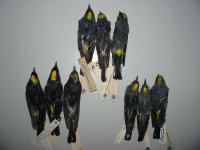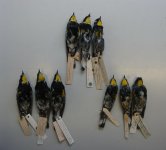ntbirdman
Well-known member
See citations and abstracts below. Brelsford and Irwin present new analysis of the hybrid zone between Myrtle and Audubon's that concludes there is post-mating selection maintaining the narrow hybrid zone despite little to no assortative mating. They suggest the two deserve species status once again.
Mila et al's phylogeny shows the Black-fronted and Goldman's forms in Mexico to be quite distinct from the Audubons/Myrtle group and Black-fronted and Goldman's to be more distinct from each other than Audubons and Myrtle are.
Combined, this seems like decent evidence for splitting the whole complex into four species. Thoughts?
Oh, and if anyone knows where photos of the two Mexican taxa can be found online, I'd appreciate it. I couldn't find any. If anyone can't access these pdfs, send me a PM with your email address.
INCIPIENT SPECIATION DESPITE LITTLE ASSORTATIVE MATING: THE YELLOW-RUMPED WARBLER HYBRID ZONE
Alan Brelsford, Darren E. Irwin
Published Online: Jul 16 2009 6:27AM
DOI: 10.1111/j.1558-5646.2009.00777.x
http://www3.interscience.wiley.com/journal/122514080/abstract
Abstract:
"Hybrid zones between recently diverged taxa are natural laboratories for speciation research, allowing us to determine whether there is reproductive isolation between divergent forms and the causes of that isolation. We present a study of a classic avian hybrid zone in North America between two subspecies of the yellow-rumped warbler (Dendroica coronata). Although previous work has shown very little differentiation in mitochondrial DNA across this hybrid zone, we identified two nuclear loci (one sex-linked and one autosomal) that show fixed differences across the hybrid zone, in a close concordance with patterns of plumage variation. Temporal stability and limited width of the hybrid zone, along with substantial linkage disequilibrium between these two diagnostic markers in the center of the zone, indicate that there is moderate reproductive isolation between these populations, with an estimated strength of selection maintaining the zone of 18%. Pairing data indicate that assortative mating is either very weak or absent, suggesting that this reproductive isolation is largely due to postmating barriers. Thus, despite extensive hybridization the two forms are distinct evolutionary groups carrying genes for divergent adaptive peaks, and this situation appears relatively stable."
Speciation and rapid phenotypic differentiation in the yellow-rumped warbler Dendroica coronata complex (p 159-173)
BORJA MILÁ, THOMAS B. SMITH, ROBERT K. WAYNE
Published Online: Oct 25 2006 12:00AM
DOI: 10.1111/j.1365-294X.2006.03119.x
http://www3.interscience.wiley.com/journal/117989605/abstract
Abstract:
The relative importance of the Pleistocene glacial cycles in driving avian speciation remains controversial, partly because species limits in many groups remain poorly understood, and because current taxonomic designations are often based on phenotypic characteristics of uncertain phylogenetic significance. We use mtDNA sequence data to examine patterns of genetic variation, sequence divergence and phylogenetic relationships between phenotypically distinct groups of the yellow-rumped warbler complex. Currently classified as a single species, the complex is composed of two North American migratory forms (myrtle warbler Dendroica coronata coronata and Audubon's warbler Dendroica coronata auduboni), and two largely sedentary forms: Dendroica coronata nigrifrons of Mexico, and Dendroica coronata goldmani of Guatemala. The latter are typically considered to be races of the Audubon's warbler based on plumage characteristics. However, mtDNA sequence data reveal that sedentary Mesoamerican forms are reciprocally monophyletic to each other and to migratory forms, from which they show a long history of isolation. In contrast, migratory myrtle and Audubon's warblers form a single cluster due to high levels of shared ancestral polymorphism as evidenced by widespread sharing of mtDNA haplotypes despite marked phenotypic differentiation. Sedentary and migratory forms diverged in the early Pleistocene, whereas phenotypic differentiation between the two migratory forms has occurred in the Holocene and is likely the result of geographical isolation and subsequent range expansion since the last glaciation. Our results underscore the importance of Quaternary climatic events in driving songbird speciation and indicate that plumage traits can evolve remarkably fast, thus rendering them potentially misleading for inferring systematic relationships.
Mila et al's phylogeny shows the Black-fronted and Goldman's forms in Mexico to be quite distinct from the Audubons/Myrtle group and Black-fronted and Goldman's to be more distinct from each other than Audubons and Myrtle are.
Combined, this seems like decent evidence for splitting the whole complex into four species. Thoughts?
Oh, and if anyone knows where photos of the two Mexican taxa can be found online, I'd appreciate it. I couldn't find any. If anyone can't access these pdfs, send me a PM with your email address.
INCIPIENT SPECIATION DESPITE LITTLE ASSORTATIVE MATING: THE YELLOW-RUMPED WARBLER HYBRID ZONE
Alan Brelsford, Darren E. Irwin
Published Online: Jul 16 2009 6:27AM
DOI: 10.1111/j.1558-5646.2009.00777.x
http://www3.interscience.wiley.com/journal/122514080/abstract
Abstract:
"Hybrid zones between recently diverged taxa are natural laboratories for speciation research, allowing us to determine whether there is reproductive isolation between divergent forms and the causes of that isolation. We present a study of a classic avian hybrid zone in North America between two subspecies of the yellow-rumped warbler (Dendroica coronata). Although previous work has shown very little differentiation in mitochondrial DNA across this hybrid zone, we identified two nuclear loci (one sex-linked and one autosomal) that show fixed differences across the hybrid zone, in a close concordance with patterns of plumage variation. Temporal stability and limited width of the hybrid zone, along with substantial linkage disequilibrium between these two diagnostic markers in the center of the zone, indicate that there is moderate reproductive isolation between these populations, with an estimated strength of selection maintaining the zone of 18%. Pairing data indicate that assortative mating is either very weak or absent, suggesting that this reproductive isolation is largely due to postmating barriers. Thus, despite extensive hybridization the two forms are distinct evolutionary groups carrying genes for divergent adaptive peaks, and this situation appears relatively stable."
Speciation and rapid phenotypic differentiation in the yellow-rumped warbler Dendroica coronata complex (p 159-173)
BORJA MILÁ, THOMAS B. SMITH, ROBERT K. WAYNE
Published Online: Oct 25 2006 12:00AM
DOI: 10.1111/j.1365-294X.2006.03119.x
http://www3.interscience.wiley.com/journal/117989605/abstract
Abstract:
The relative importance of the Pleistocene glacial cycles in driving avian speciation remains controversial, partly because species limits in many groups remain poorly understood, and because current taxonomic designations are often based on phenotypic characteristics of uncertain phylogenetic significance. We use mtDNA sequence data to examine patterns of genetic variation, sequence divergence and phylogenetic relationships between phenotypically distinct groups of the yellow-rumped warbler complex. Currently classified as a single species, the complex is composed of two North American migratory forms (myrtle warbler Dendroica coronata coronata and Audubon's warbler Dendroica coronata auduboni), and two largely sedentary forms: Dendroica coronata nigrifrons of Mexico, and Dendroica coronata goldmani of Guatemala. The latter are typically considered to be races of the Audubon's warbler based on plumage characteristics. However, mtDNA sequence data reveal that sedentary Mesoamerican forms are reciprocally monophyletic to each other and to migratory forms, from which they show a long history of isolation. In contrast, migratory myrtle and Audubon's warblers form a single cluster due to high levels of shared ancestral polymorphism as evidenced by widespread sharing of mtDNA haplotypes despite marked phenotypic differentiation. Sedentary and migratory forms diverged in the early Pleistocene, whereas phenotypic differentiation between the two migratory forms has occurred in the Holocene and is likely the result of geographical isolation and subsequent range expansion since the last glaciation. Our results underscore the importance of Quaternary climatic events in driving songbird speciation and indicate that plumage traits can evolve remarkably fast, thus rendering them potentially misleading for inferring systematic relationships.








